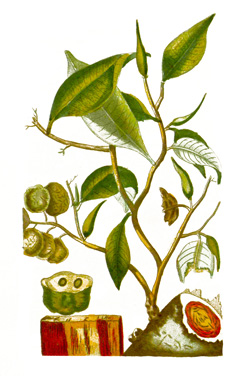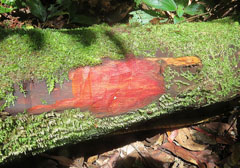 |
|
https://edibleplants.org/ |
 |
| Dick Culbert wikimedia.org |
Translate this page:
Summary
Bloodwood Cacique or Brosimum rubiscens is an evergreen tree that grows up to 40 m tall with trunk diameter of up to 5 0 -70 cm. It has no buttresses, and its crown is small. It is found in wet evergreen forests at low elevations in South America. The latex is drunk to treat colds and cough. Bloodwood cacique is valued for its very hard and durable, high-quality wood that is resistant to termite attacks. It is used in furniture-making, carpentry, parquet flooring, etc.
Physical Characteristics

 Brosimum rubescens is an evergreen Tree growing to 30 m (98ft) by 20 m (65ft) at a medium rate.
Brosimum rubescens is an evergreen Tree growing to 30 m (98ft) by 20 m (65ft) at a medium rate.
See above for USDA hardiness. It is hardy to UK zone 10.
Suitable for: light (sandy), medium (loamy) and heavy (clay) soils. Suitable pH: mildly acid, neutral and basic (mildly alkaline) soils. It can grow in full shade (deep woodland) or semi-shade (light woodland). It prefers moist soil.
UK Hardiness Map
US Hardiness Map
Synonyms
Brosimum paraense Huber
Plant Habitats
Edible Uses
References More on Edible Uses
Medicinal Uses
Plants For A Future can not take any responsibility for any adverse effects from the use of plants. Always seek advice from a professional before using a plant medicinally.
Antitussive
The latex is drunk as a medication for colds or for coughing[ 348 ].
References More on Medicinal Uses
The Bookshop: Edible Plant Books
Our Latest books on Perennial Plants For Food Forests and Permaculture Gardens in paperback or digital formats.

Edible Tropical Plants
Food Forest Plants for Hotter Conditions: 250+ Plants For Tropical Food Forests & Permaculture Gardens.
More

Edible Temperate Plants
Plants for Your Food Forest: 500 Plants for Temperate Food Forests & Permaculture Gardens.
More

More Books
PFAF have eight books available in paperback and digital formats. Browse the shop for more information.
Shop Now
Other Uses
Furniture Latex Wood
Other uses rating: High (4/5). Other Uses: The heartwood is dark red, often with darker veins; it is clearly demarcated from the 4 - 20cm wide band of sapwood. The texture is fine; the grain straight or interlocked. The wood is very hard, dense, very heavy; durable, with a high resistance to wood-eating organisms. It is slow to season, with only a slight risk of checking or distortion; once dry it is stable in service. The wood has a fairly high blunting effect, stellite-tipped and tungsten carbide tools are recommended; it finishes well with a beautiful polish; nailing and screwing are good, but pre-boring is required; gluing is correct for internal purposes, but requires care because of the denseness of the wood. A very good quality wood, it is used for making high value items such as furniture, musical instruments, parquet flooring, wood ware, turned goods and fancy carpentry[ 46 , 625 , 848 ].
Special Uses
References More on Other Uses
Cultivation details
Prefers a position with some shade[ 625 ]. Newly planted young trees have a moderate rate of growth[ 625 ].
References Carbon Farming Information and Carbon Sequestration Information
Temperature Converter
Type a value in the Celsius field to convert the value to Fahrenheit:
Fahrenheit:
The PFAF Bookshop
Plants For A Future have a number of books available in paperback and digital form. Book titles include Edible Plants, Edible Perennials, Edible Trees,Edible Shrubs, Woodland Gardening, and Temperate Food Forest Plants. Our new book is Food Forest Plants For Hotter Conditions (Tropical and Sub-Tropical).
Shop Now
Plant Propagation
Seed - best sown as soon as it is ripe. Sow in individual containers, placed in partial shade. Germination rates are usually low, with the seed sprouting within 40 - 60 days[ 625 ].
Other Names
If available other names are mentioned here
Bloodwood Cacique or Brosimum rubiscens
Native Range
SOUTHERN AMERICA: Panama, French Guiana, Guyana, Suriname, Brazil (Acre, Amapá, Amazonas, Bahia, Goiás, Pará, Rio de Janeiro, Rondônia, Roraima), Bolivia (Pando), Colombia (east), Ecuador (Morona Santiago, Napo, Pastaza, Sucumbíos), Peru (Amazonas, Madre de Dios, Pasco, San Martín)
Weed Potential
Right plant wrong place. We are currently updating this section.
Please note that a plant may be invasive in one area but may not in your area so it's worth checking.
None Known
Conservation Status
IUCN Red List of Threatened Plants Status : This taxon has not yet been assessed.

Growth: S = slow M = medium F = fast. Soil: L = light (sandy) M = medium H = heavy (clay). pH: A = acid N = neutral B = basic (alkaline). Shade: F = full shade S = semi-shade N = no shade. Moisture: D = dry M = Moist We = wet Wa = water.
Now available:
Food Forest Plants for Mediterranean Conditions
350+ Perennial Plants For Mediterranean and Drier Food Forests and Permaculture Gardens.
[Paperback and eBook]
This is the third in Plants For A Future's series of plant guides for food forests tailored to
specific climate zones. Following volumes on temperate and tropical ecosystems, this book focuses
on species suited to Mediterranean conditions—regions with hot, dry summers and cool, wet winters,
often facing the added challenge of climate change.
Read More
Expert comment
Author
Taub.
Botanical References
Links / References
For a list of references used on this page please go here
A special thanks to Ken Fern for some of the information used on this page.
Readers comment
| Add a comment |
|
If you have important information about this plant that may help other users please add a comment or link below. Only comments or links that are felt to be directly relevant to a plant will be included. If you think a comment/link or information contained on this page is inaccurate or misleading we would welcome your feedback at [email protected]. If you have questions about a plant please use the Forum on this website as we do not have the resources to answer questions ourselves.
* Please note: the comments by website users are not necessarily those held by PFAF and may give misleading or inaccurate information.
To leave a comment please Register or login here All comments need to be approved so will not appear immediately.
|
Subject : Brosimum rubescens
|
|
|
|